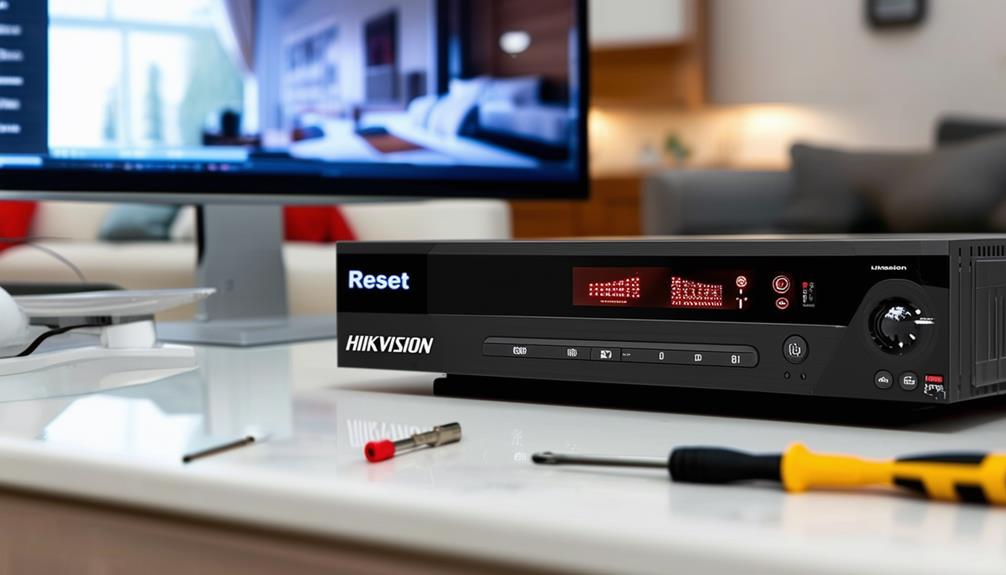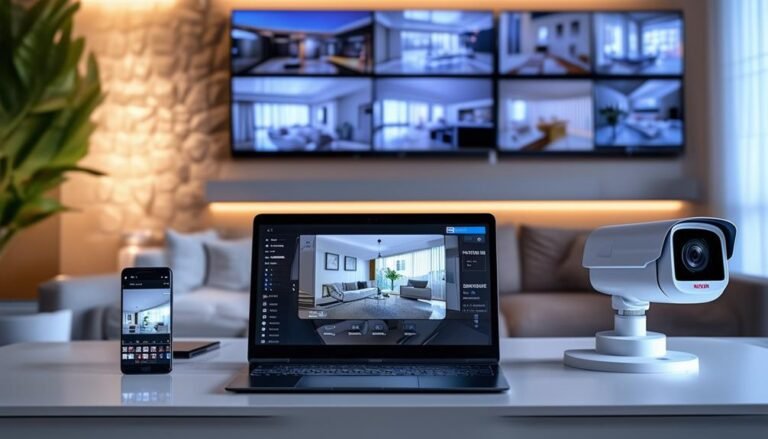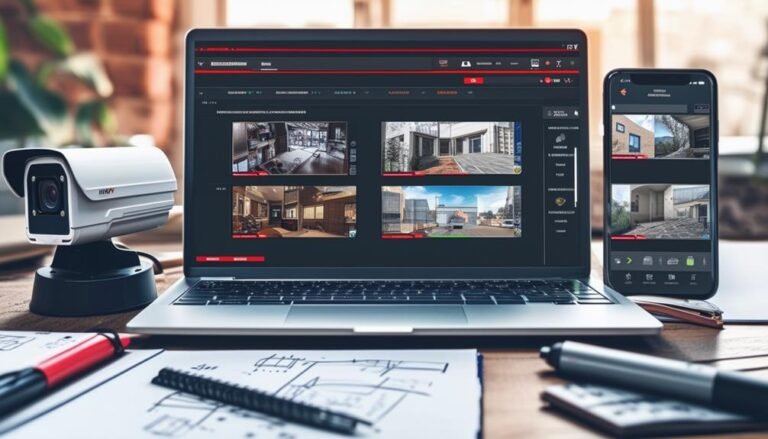To factory reset your Hikvision DVR without a password, power on the device and connect it to a monitor. Use the mouse or remote to access the main menu. Navigate to “Configuration,” then select “System.” Look for the “Restore” or “Factory Default” option and confirm the action. If you’re unable to access the menu, check for a physical reset button on the device, usually found on the back. Press and hold this button until the device reboots. This process will wipe all settings, and you’ll be back to square one, ready to set it up fresh. There’s more to learn about configuring your device after the reset.
Understanding Hikvision DVR Models
When you’re considering a factory reset for your Hikvision DVR, it’s vital to understand that different models have varying features and interfaces. Each model might present unique settings or options that could affect how you approach the reset process. Familiarizing yourself with your specific DVR model will empower you, giving you the confidence to navigate its settings effectively.
Start by identifying your DVR model number, usually found on a label on the device’s back or bottom. This number is your key to accessing the relevant information about its functions. Once you know your model, you can look up its manual online, where you’ll find detailed guidance tailored to your device. Knowing whether you have a standalone DVR, a networked one, or an NVR can also influence your reset strategy.
Some models may have a reset button, while others require you to access the menu. You’ll want to take note of these differences, as they can greatly impact the steps you take. For instance, if your model uses a web interface, understanding how to log in and navigate the settings will save you time and headaches.
In essence, understanding your specific Hikvision DVR model gives you the freedom to handle the factory reset process with ease. By arming yourself with the right knowledge, you’ll promote a smoother experience, allowing you to regain control over your device. So take a moment to familiarize yourself with your DVR model today!
Reasons for Factory Resetting
Understanding your Hikvision DVR model not only helps in maneuvering its settings but also clarifies why you might need to perform a factory reset. There are several compelling reasons to take into account this option, especially if you’re looking to regain control over your device.
One of the main reasons for a factory reset is if you’ve forgotten your password. It can be frustrating to be locked out, and resetting the DVR can give you a fresh start. Additionally, if you’re experiencing persistent issues, like software glitches or connectivity problems, a reset can often resolve these annoying bugs, restoring your DVR to peak performance.
Another reason could be when you’re switching ownership of the device. If you’re selling or giving away your DVR, resetting guarantees that your personal information is wiped clean, providing peace of mind for both you and the new user. Finally, if you’ve made changes that you can’t reverse or if the settings have become a bit chaotic, a reset can bring everything back to the original factory state.
Here’s a quick overview of the reasons for a factory reset:
| Reason for Factory Reset | Description |
|---|---|
| Forgotten Password | Regain access to your DVR |
| Persistent Software Issues | Fix glitches and connectivity problems |
| Change of Ownership | Wipe personal data before selling |
| Unwanted Configuration Changes | Restore original settings |
| Enhancing Device Performance | Refresh the device for peak operation |
Take these reasons carefully as you decide whether a factory reset is right for you.
Preparing for the Reset
Before you reset your Hikvision DVR, make sure to back up any important data you want to keep. You’ll also need to gather the necessary tools, like a monitor and a mouse, to assist in the process. Understanding the reset procedure is essential, so let’s go over what you need to know.
Backup Important Data
Backing up important data is essential before you reset your Hikvision DVR. You don’t want to lose vital footage or settings that you’ve put time and effort into. Start by identifying what you need to save. This usually includes recorded videos, configurations, and any other personalized settings that help your system run smoothly.
Next, take the time to transfer your footage to a secure location. You can use an external hard drive or a cloud service for this purpose. Make sure you have enough storage space to accommodate all your data. It’s a good idea to check the integrity of the files after transferring them, ensuring that everything is intact and accessible.
Also, consider documenting your current settings. This could include network configurations, camera positions, and any specific adjustments you’ve made. Having this information on hand will save you time when you set everything back up after the reset.
Gather Necessary Tools
Once you’ve secured your data, it’s time to gather the necessary tools for the factory reset of your Hikvision DVR. First, you’ll need a small Phillips-head screwdriver. This will help you access the DVR’s casing, allowing you to reach the reset button. If you don’t have one handy, it’s worth picking up from a local hardware store.
Next, have a paperclip or a similar object ready. You’ll use this to press the reset button, which is usually located inside the device. Having a flashlight might also come in handy, especially if you’re working in a dimly lit area — it’ll help you see clearly while you’re exploring the insides of the DVR.
Lastly, make sure you have a comfortable and static-free workspace. A mat or a towel can provide a clean surface for your DVR while you work. It’s all about creating an environment where you can focus without distractions. With these tools at your disposal, you’re well on your way to regaining control over your device, so let’s get started!
Understand Reset Process
Understanding the reset process is crucial to guaranteeing a smooth factory reset of your Hikvision DVR. You want to regain control over your device, and knowing the steps involved can make all the difference. First, familiarize yourself with the specific model of your DVR, as the reset procedure might vary slightly between models.
Next, make sure that you have a stable power source during the reset process. Interruptions can create complications, so it’s best to avoid any potential disruptions. Before starting, back up any important data if possible, as a factory reset will erase everything.
When you’re ready, locate the reset button, usually found on the back of the unit. You’ll need a pin or a similar tool to press it. Hold the button for a few seconds until you see the device reboot.
Step-by-Step Reset Process
To initiate the factory reset of your Hikvision DVR, you’ll need to follow a straightforward step-by-step process. First, verify your DVR is powered on and connected to a monitor. You’ll want to access the main menu, so grab your mouse or remote control and click on the “Menu” button.
Once you’re in the menu, navigate to the “Configuration” section. Look for the “System” option, which will lead you to a submenu. Here, you should find the “Restore” or “Factory Default” option. Click on it, and a warning message will likely pop up to remind you that this action will erase all current settings. Don’t fret—this is necessary to regain control!
Confirm your choice by clicking “OK” or “Yes.” After that, your DVR will start the reset process. This might take a few minutes, so be patient and don’t turn off the device during this time. Once it’s completed, the DVR should automatically reboot.
When it restarts, you’ll be greeted with the initial setup screen, just like when you first got your device. Now you’re free to configure it according to your preferences. Remember, if you need any additional assistance, feel free to refer to the user manual or seek out online resources tailored to your specific model. Enjoy the newfound control over your system!
Post-Reset Configuration
After resetting your Hikvision DVR, it’s important to set up user accounts to enhance security. You’ll also need to configure the network settings to make sure your device connects properly to your network. Let’s go through these vital steps to get your system up and running smoothly.
Setting Up User Accounts
Setting up user accounts is essential for maintaining security and managing access to your Hikvision DVR after a factory reset. You want to guarantee that only trusted individuals can access your system, so start by creating a primary administrator account. This account should have full privileges to make changes and manage settings. Use a strong password that’s unique and hard to guess—this is your first line of defense.
Next, consider adding additional user accounts with varying levels of access. For instance, if you have staff who need to monitor the cameras, you can create a user role with viewing permissions only. This way, they can keep an eye on things without being able to alter critical settings.
When setting up user accounts, it’s also a good idea to regularly review and update permissions. If someone no longer needs access, remove their account to prevent unauthorized entry. Remember, freedom comes with responsibility, so take your account management seriously. After all, you want your Hikvision DVR to be as secure as possible while allowing the right people to do their jobs efficiently.
Configuring Network Settings
Configuring the network settings on your Hikvision DVR is essential for ensuring remote access and proper functionality after a factory reset. Once you’ve reset your device, you’ll want to set up your network settings correctly to regain control and flexibility. Here’s how to do it:
- Connect your DVR to the network using an Ethernet cable or Wi-Fi.
- Access the DVR’s menu by logging in with your newly created user account.
- Navigate to the Network settings section to enter the necessary details.
- Configure the following settings:
- IP Address: Assign a static IP address to avoid conflicts.
- Subnet Mask: Typically set to 255.255.255.0 for most networks.
- Gateway: Input your router’s IP for internet access.
- DNS: Use your ISP’s DNS or public DNS for better resolution.
Troubleshooting Common Issues
When troubleshooting common issues with your Hikvision DVR, it is essential to follow a methodical approach. Start by checking the power supply; confirm the device is plugged in and that all cables are secure. If your DVR isn’t turning on, try a different outlet or power cable—sometimes, it’s just a simple fix.
Next, if you’re experiencing video loss or poor image quality, inspect the connections between your DVR and cameras. Loose or damaged cables can lead to interruptions. You should also verify that the cameras are powered and functioning properly. If they’re powered but still not displaying, consider resetting the cameras or checking the settings in the DVR menu.
Another common issue is network connectivity. If you can’t access the DVR remotely, check your network settings. Make sure your DVR is connected to the network, and confirm that the IP address settings are correct. You may also need to check your router settings, as firewalls or blocked ports can prevent access.
Lastly, if you encounter error messages, consult the user manual for specific troubleshooting steps related to those errors. Sometimes, a factory reset may be necessary to clear persistent issues, but remember this will erase all your settings. If you’ve tried all these steps and still face problems, contacting Hikvision support can provide you with additional options and insights.
Frequently Asked Questions
Can I Recover Lost Recordings After a Factory Reset?
You might wonder if you can recover lost recordings after a factory reset. Unfortunately, once a device is reset, all stored data, including recordings, is typically erased and can’t be retrieved. It’s a harsh reality, but it emphasizes the importance of regularly backing up your footage. If freedom to access your recordings matters to you, consider investing in additional storage solutions or cloud services for future security and peace of mind.
Will a Reset Delete My Custom Settings?
Yes, a reset will delete your custom settings. When you factory reset your device, it returns to its original state, wiping out any personalized configurations you’ve made. This means you’ll have to set everything up again, from camera angles to recording schedules. If you value your custom settings, it might be wise to back them up first or document them so you can easily restore your preferred setup after the reset.
Is There a Way to Unlock DVR Without Resetting?
If you’re looking to gain access to your DVR without resetting it, you might have a few options. Check if there’s a default password that you can use. Sometimes, manufacturers provide a universal code. You could also try contacting customer support for assistance; they may guide you through a recovery process without losing your settings. Just remember, always keep a record of your passwords to avoid this situation in the future!
What if My DVR Won’t Respond to the Reset Process?
If your DVR’s playing hard to get and won’t respond to the reset process, don’t lose hope just yet! You might want to check the power source, ensuring it’s connected properly. Sometimes, a gentle nudge in the form of a reboot can work wonders. If that doesn’t do the trick, consider reaching out to tech support for a helping hand. You deserve a seamless experience with your device, after all!
Can I Perform a Factory Reset Remotely?
Yes, you can perform a factory reset remotely, but it depends on your DVR’s capabilities and network setup. If your device supports remote management, you’ll likely find the option in the settings menu. Just remember, resetting it will erase all your configurations and recordings, so make sure you’re ready for that. If you’re uncertain, it might be wise to consult the user manual or contact support to avoid any unexpected issues.



